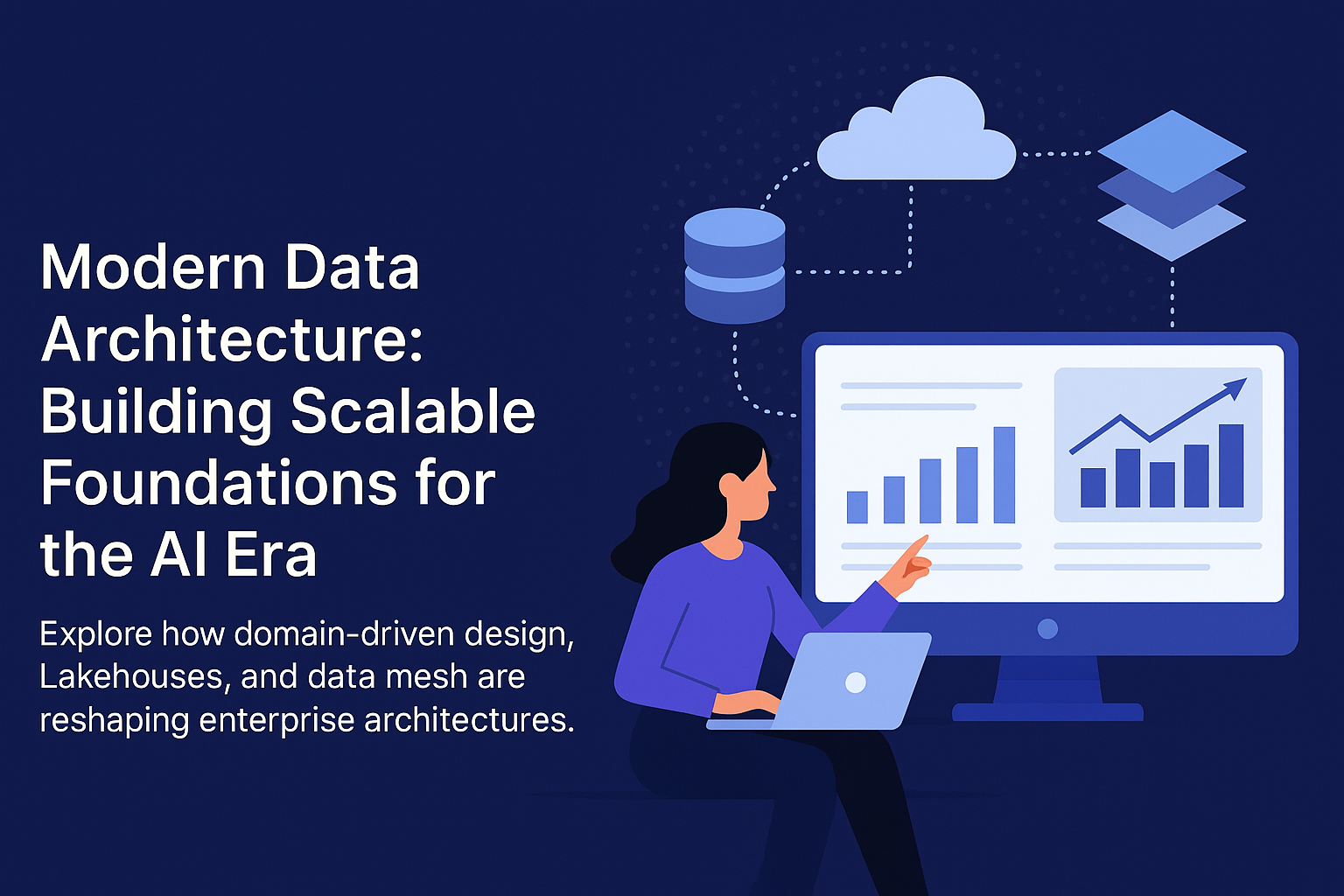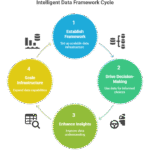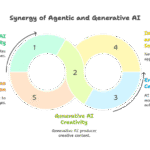In today’s data-driven world, enterprises are racing to harness the power of artificial intelligence (AI) to drive innovation, optimize operations, and deliver personalized customer experiences. However, the success of AI initiatives hinges on a robust, scalable, and flexible data architecture. Traditional data systems, often rigid and siloed, are no longer sufficient to meet the demands of the AI era. Enter modern data architectures—innovative frameworks like domain-driven design (DDD), data Lakehouse, and data mesh—that are reshaping how organizations manage and leverage data. In this blog, we explore how these paradigms are transforming enterprise architectures, drawing insights from industry leaders like Databricks, Snowflake, and AWS, and outlining best practices for building scalable foundations for AI-driven success.
The Evolution of Data Architecture
Data architecture has evolved significantly over the past few decades. In the pre-2000 era, enterprise data warehouses (EDWs) dominated, focusing on structured data and predefined schemas. The 2010s saw the rise of data lakes, which offered flexibility for handling unstructured and semi-structured data but often led to data swamps due to poor governance. Today, as AI and machine learning (ML) become strategic imperatives, modern data architectures are designed to support real-time processing, diverse data types, and decentralized governance.
According to Gartner, modern data architectures must balance scalability, flexibility, and governance to support AI-driven use cases like generative AI, predictive analytics, and intelligent agents. Industry leaders emphasize that modern data architectures are critical for breaking down silos, ensuring data quality, and enabling real-time decision-making. This evolution is driven by the need to manage massive data volumes—projected to reach 394 zettabytes by 2028—and the growing adoption of cloud-native platforms.
Key Components of Modern Data Architecture
Modern data architectures are built on several core components that enable scalability and AI readiness:
- Data Lakehouse: Combining the flexibility of data lakes with the structured querying capabilities of data warehouses, Lakehouses provide a unified platform for analytics and AI. Databricks, a pioneer in this space, champions the Lakehouse architecture, leveraging open-source formats like Delta Lake to ensure scalability and governance. Lakehouses simplify data management by enabling organizations to store raw and structured data in a single system, supporting advanced analytics and ML workloads.
- Domain-Driven Design (DDD): Inspired by software design principles, DDD in data architecture organizes data around business domains, aligning it with organizational capabilities. AWS highlights DDD as a cornerstone of data mesh, enabling decentralized data ownership while maintaining centralized governance. This approach ensures that data is managed by those closest to it, improving agility and reducing bottlenecks.
- Data Mesh: A decentralized approach to data management, data mesh treats data as a product, with domain teams owning their data pipelines and products. Companies like Kroger have adopted data mesh to break down silos and improve data accessibility, using data fabric as the connective tissue for interoperability. Data mesh empowers business units to innovate while adhering to governance standards set by central authorities like the Chief Data Officer (CDO).
- Data Fabric: This architecture uses metadata-driven automation to integrate and manage data across hybrid and multi-cloud environments. Informatica’s Intelligent Data Management Cloud (IDMC) exemplifies this, leveraging AI to automate data integration and governance, ensuring data is accessible and trustworthy for AI applications.
These components, when combined, create a flexible, scalable ecosystem that supports the diverse needs of AI-driven enterprises, from real-time analytics to large-scale ML model training.
Why Modern Data Architecture Matters for AI
AI and ML workloads demand more than traditional architectures can deliver. Large language models (LLMs), computer vision systems, and generative AI require access to diverse data types—structured, unstructured, and semi-structured—in real time. According to McKinsey, organizations with modern data architectures can reduce AI development costs by up to 30% by streamlining data access and improving data quality. Here’s why modern data architectures are critical for the AI era:
- Real-Time Processing: Real-time analytics, enabled by platforms like AWS’s data lakehouse solutions, allow organizations to respond to market changes instantly. For example, Netflix uses real-time data architectures to deliver personalized recommendations, reducing churn and enhancing user engagement.
- Scalability: Cloud-native architectures, supported by vendors like Snowflake, provide the elasticity needed to handle massive data growth. Snowflake’s cloud data platform enables seamless scaling across hybrid environments, ensuring performance for AI workloads.
- Governance and Trust: AI models are only as good as the data they’re trained on. Data mesh and fabric architectures, as implemented by Cloudera, ensure data quality and compliance with regulations like GDPR and CCPA, fostering trust in AI outcomes.
- Unified Analytics: Lakehouses eliminate the need for separate data lakes and warehouses, simplifying workflows.
The Future of Data Architecture
As AI continues to evolve, so will data architectures. Emerging trends include:
- Active Metadata: Gartner predicts a shift to active metadata, enabling automation and self-service analytics.
- AI-Driven Automation: AI will play a larger role in optimizing data pipelines, as seen in Informatica’s IDMC.
- Edge Computing and IoT: Architectures will need to support data from IoT devices and edge computing, as highlighted in 365 Data Science’s course on modern data architectures.
By 2028, the data mesh market is projected to reach $2.5 billion, and the data lakehouse market is expected to grow to $66 billion by 2033, signaling strong adoption of these paradigms.
By Bloomsberg
Conclusion
As data volumes surge and AI becomes ubiquitous, enterprises must evolve beyond legacy systems toward architectures that are resilient, intelligent, and adaptive. By embracing domain-driven design, lakehouses, and data mesh, organizations can lay a future-proof foundation for AI-driven innovation.





